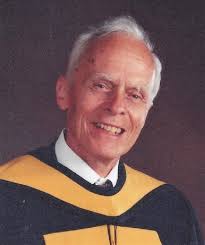Remembering Campbell L. Searle, 1926-2020

Professor Campbell (“Cam”) L. Searle
EECS Staff
Longtime EECS Professor Campbell (Cam) Searle passed away peacefully at his home in Topsham, Maine, on Jan. 5, 2020, surrounded by his family. He was 93.
Searle was associated with MIT for more than 40 years, earning a master’s degree in electrical engineering in 1951, then serving as a professor, mentor, and researcher until his retirement in 1992.
Former colleagues recall that, in 1960, Searle gathered a team of 31 electrical-engineering educators to develop a new curriculum to teach semiconductor devices and circuits, a new field at the time. “Because of its scientific rather than empirical basis, this curriculum could adapt to advances in technology,” notes emeritus professor and former EECS department head Paul Penfield. “Modern versions of it are in use around the world to this day.”
Penfield and others also have also praised Searle for his role in developing the department’s highly successful Master’s of Engineering (MEng) program. Launched in 1993, the program allows EECS undergraduates to earn both a bachelor’s and a master’s degree in five to five-and-a-half years. “Today, it is hard to imagine how radical our MEng program seemed when first presented to the EECS faculty in 1991 and more broadly to MIT the following year,” recalls John Guttag, Dugald C. Jackson Professor of EECS, who worked with Searle in developing the MEng program. “There was nothing like it at MIT, and many were convinced that it was going to fail. Cam played a key role in convincing our colleagues to give it a try.”
With EECS colleague (and later, MIT President) Paul E. Gray, Searle wrote the textbook “Principles of Transistor Electronics.” Translated into multiple other languages, the book became the definitive introduction to the subject for generations of students.
Stephen Senturia, EECS professor emeritus, recalls that, early in his career, he taught a section of an electronics class in which Searle and Gray were lecturers. “What an inspiring, gentle, kind, and good-humored man,” Senturia says of Searle. “And both he and Paul showed me, through their actions, how to be an effective classroom teacher. His voice was calm — I can hear it to this day — and he seemed to take a positive view even when, as often happens in a large course, something might go wrong: a garbled assignment, a bad problem design on a test.”
Guttag also describes Searle as even-tempered, cordial, and respectful, but add: “That is not to say that he didn’t have strong opinions about what should and shouldn’t be done. He won arguments by the force of logic, not by being louder or more stubborn than others.” Colleagues say Searle will also be remembered for his dedication to the department — and, most of all, to its students. “If you ask me what his MIT legacy was, I would describe it this way: teach your students well, but with kindness,” Senturia says. “He did this better than anyone.”
Searle was born July 24, 1926, in Winnipeg, Manitoba, Canada, to Stewart and Sally Searle. He received a bachelor’s degree at Queen’s University in Kingston, Ontario, Canada, before coming to MIT. (Queen’s University would later acknowledge Searle’s accomplishments by awarding him an honorary doctorate in 1998.)
He married Eleanor Whittlesey Reed in 1953. They had five children, four of whom survive. The family lived in Weston, Massachusetts, during the school year, but spent summers in Boothbay, Maine.
Family members say that, after retiring, Searle kept busy with swing dancing and volunteering with Habitat for Humanity, among other pursuits. He also continued his research, collaborating in recent years with former students on a new theory about how nerve cells work. He and his wife moved to Maine in 2002 to be closer to their grandchildren.
Searle was pre-deceased by his wife, his parents, his brother Stewart Searle, Jr., and his son Robert. He is survived by his children Catherine (Peter) Searle Renault of Topsham, Maine; Susan (Takahiro) Searle Sato of Gorham, Maine; Sally Searle Kent of Bowdoin, Maine; and Campbell Reed Searle of Albuquerque, New Mexico; his grandchildren, Eleanor Yoko Sato and Stephen Liam Campbell Kent; and his “grand-dog” Winifred.
Funeral arrangements were private. Donations may be made to: Habitat for Humanity 7Rivers, 124 Main Street, Topsham, ME 04086.
With the family’s permission, information from this published obituary was included in this report. Photo courtesy of the Searle family.
Media Inquiries
Journalists seeking information about EECS, or interviews with EECS faculty members, should email eecs-communications@mit.edu.
Please note: The EECS Communications Office only handles media inquiries related to MIT’s Department of Electrical Engineering & Computer Science. Please visit other school, department, laboratory, or center websites to locate their dedicated media-relations teams.